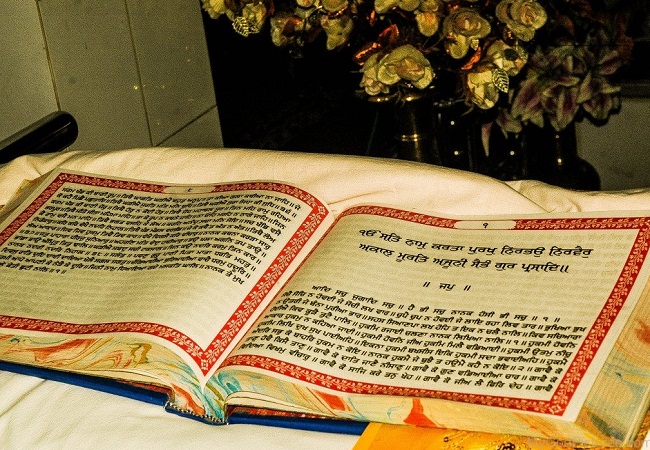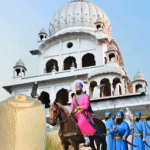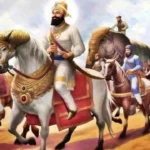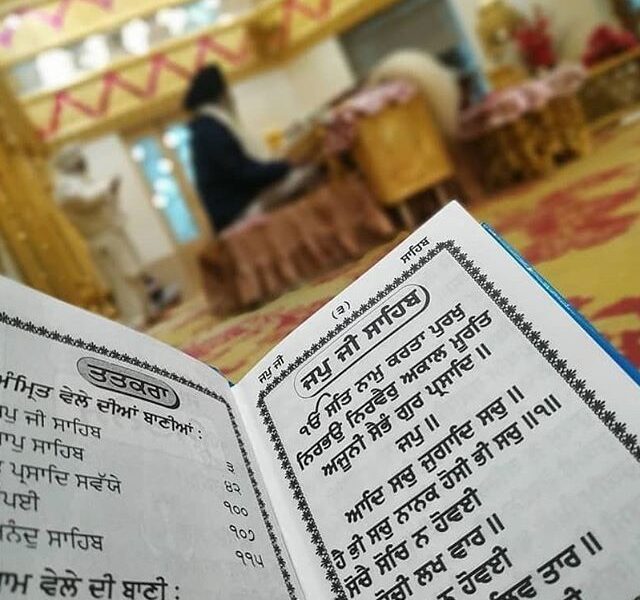The Guru Granth Sahib holds a unique and central place in Sikhism, serving as both a spiritual guide and the living Guru for the Sikh community. Here are some key points:
Living Guru
The Guru Granth Sahib is not just a scripture; it is considered the living Guru by Sikhs in sikh religion. This distinction sets Sikhism apart, as the Guru Granth Sahib is treated with the same reverence and respect that would be given to a living Guru.
Compilation and Content
The holy text spans 1430 pages and contains the actual words spoken by the founders of the Sikh religion, including the Ten Gurus of Sikhism. It also includes the words of various saints from other religions, like Sant Kabir etc. emphasizing the universal and inclusive nature of the teachings.
Guruship Transfer
Guru Gobind Singh Ji, the last of the living Sikh Masters, conferred the Guruship to the Guru Granth Sahib in 1708. Sikhs are commanded to treat the Granth Sahib as their next Guru, and this directive is encapsulated in the phrase “Sab Sikhan ko hokam hai Guru Manyo Granth,” meaning “All Sikhs are commanded to take the Granth as Guru.”
Gurdwara Setting
In Gurdwaras, the Guru Granth Sahib is prominently placed in the Darbar Sahib or Main Hall. It is positioned on a raised platform, covered with an attractively colored cloth, and protected by a canopy, reflecting the deep respect and reverence accorded to the Guru Granth Sahib. Chaur Sahib is found next to the Manji Sahib where the Sri Guru Granth Sahib is placed during the day within the Gurdwara’s Darbar Sahib (Main Hall). The Chaur is used to fan Guru Granth Sahib Ji as a sign of reverence and respect for the scriptures.
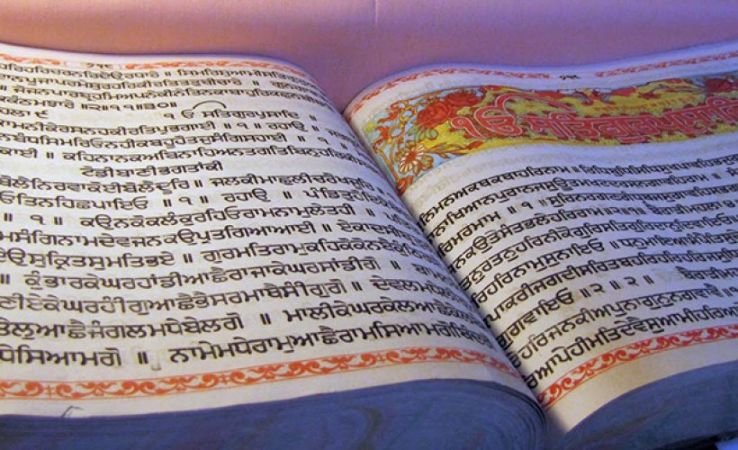
Script and Language
The Guru Granth Sahib is written in Gurmukhi, a script that translates to “From the Guru’s mouth.” It is considered a modern development of the ancient language Sanskrit.
Universal Message
The inclusion of writings from various religious traditions, such as Hinduism and Islam, underscores the Guru Granth Sahib’s universal and all-encompassing teachings.
Total of 11 Gurus
Sikhs recognize a total of 11 Gurus, with the 10 Gurus in human form and the Guru Granth Sahib as the spiritual guide following Guru Gobind Singh Ji’s directive. The Guru Granth Sahib, with its rich and diverse content, continues to guide Sikhs on the path of spirituality, equality, and righteousness. It serves as a source of inspiration and wisdom for the Sikh community and anyone seeking spiritual enlightenment.
History
The history and composition of the Guru Granth Sahib, the central religious scripture of Sikhism, are deeply rooted in the teachings of the Sikh Gurus. Here is a detailed overview:
Guru Nanak Dev Ji- Pratham Guru
Word of God Manifest: Guru Nanak Dev Ji, the founder of Sikhism, is believed to have brought the “Word of God” to Earth. His hymns and prayers (Shabads) were not only a source of inspiration but also a guide for living a life of truth, righteousness, and spirituality. Singing by Companions: Bala and Mardana, companions of Guru Nanak, are said to have sung these enlightening words. Additionally, Sikh congregations (Sangats) that grew around Guru Nanak also participated in singing these hymns.
Guru Nanak Dev Ji initiated the Langar system, and Guru Angad Dev Ji further developed it. In this system, people from all walks of life, regardless of their religion, caste, class, creed, or gender, gathered to share meals together. The Langar system played a crucial role in fostering a sense of unity, cooperation, and charity within the Sikh community.
The Langar system is still very much a part of Sikh tradition and is actively followed. Sikh Gurdwaras (places of worship) around the world continue to practice the Langar, offering free meals to all visitors, regardless of their background. This practice embodies the Sikh principles of equality, community service, and inclusivity. The Langar remains a symbol of Sikh values and a tangible expression of the commitment to selfless service and communal harmony.
Guru Nanak’s Later Years
Daily Recitation: In Guru Nanak’s later years at Kartarpur, it became a tradition for the Sikh community to recite certain hymns daily. For example, Japji in the morning and So Dar and So Purakh (the beginnings of Rehiras) in the evenings.
“Sikh Maryada” refers to the Sikh code of conduct or Sikh principles and customs that guide the religious and social practices of the Sikh community. It encompasses the guidelines and rules that Sikhs are encouraged to follow in their daily lives. The term “Maryada” translates to “code of conduct” or “discipline,” and it outlines the proper way of living as per Sikh teachings.
The Sikh Rehat Maryada, established by the Shiromani Gurdwara Parbandhak Committee (SGPC), is the official code of conduct for Sikhs. It covers various aspects of Sikh life, including religious practices, ceremonies, and social conduct. The Sikh Rehat Maryada was formulated to provide a standardized set of guidelines for Sikhs globally and ensure consistency in religious practices.
Successive Gurus
Contribution of Guru Angad, Guru Amar Das, and Guru Ram Das: Successive Gurus, including Guru Angad, Guru Amar Das, and Guru Ram Das, also composed Shabads (hymns). The Sikhs began to collect these compositions in small books called that contain hymns, prayers, or writings related to the teachings of the Sikh Gurus. These Pothis were compiled and used during the early years of Sikh history to preserve and transmit the sacred hymns and compositions of the Gurus.
Each Guru contributed to this collection by composing hymns that reflected their spiritual insights and teachings. These Pothis served as a means of preserving and sharing the divine wisdom imparted by the Gurus.
Over time, as the number of Sikh Gurus increased, and the collection of hymns expanded, the need for a more standardized and comprehensive compilation arose. This led to the compilation of the Guru Granth Sahib under the guidance of Guru Arjun, the fifth Sikh Guru.
The Guru Granth Sahib, also known as the Adi Granth, is the central religious scripture of Sikhism and is considered the eternal Guru by Sikhs. It includes the hymns of the Sikh Gurus as well as contributions from Hindu and Muslim saints. The compilation of the Guru Granth Sahib was a significant step in establishing a unified and standardized scripture for the Sikh community.
Evolution of Pothis
Compilation of Hymns: The hymns composed by the Gurus were collected and compiled in Pothis. These early manuscripts contained the divine poetry and teachings of the Sikh Gurus. While Pothis were the early collections of Sikh hymns, the Guru Granth Sahib is the final and eternal compilation that Sikhs turn to for spiritual guidance and inspiration.
Guru Arjan Dev Ji
Compilation of Guru Granth Sahib: Guru Arjan Dev Ji, the fifth Guru of Sikhism, undertook the monumental task of compiling the hymns of the Sikh Gurus and other spiritual leaders into a single volume. This compilation is known as the Adi Granth. Inclusive Approach: Guru Arjan Dev included hymns not only from Sikh Gurus but also from saints and poets of different religious traditions, reflecting the inclusive nature of Sikhism. Installation as Guru: In 1604, Guru Arjan Dev installed the Adi Granth as the Guru, declaring it the eternal Guru for Sikhs. This marked a significant development in Sikh spirituality.
Guru Gobind Singh Ji
Final Guruship to Guru Granth Sahib: Guru Gobind Singh Ji, the tenth Guru, affirmed the eternal Guruship of the Guru Granth Sahib. Before his demise in 1708, he declared that Sikhs should treat the Guru Granth Sahib as their next Guru.
Guru Granth Sahib Today
Living Guru: Sikhs consider the Guru Granth Sahib their living Guru and turn to its teachings for spiritual guidance. Central Role in Sikh Worship: In Gurdwaras, the Guru Granth Sahib is accorded a central place, and Sikhs gather to listen to its recitation, sing hymns, and seek spiritual inspiration. The Guru Granth Sahib, with its compilation of divine poetry and teachings, serves as a beacon of spiritual wisdom and a guide for Sikhs on their journey toward truth and enlightenment.
Standardisation of Shabads
The standardization of Shabads (hymns) and the compilation of a unified scripture were significant steps taken by Guru Arjan Dev Ji to preserve the authenticity and integrity of the teachings of the Sikh Gurus. Here is more information on this aspect of Sikh history:
Challenges in Early Sikh History
Mal-Quotations and Pretenders: Early in Sikh history, there were instances of mal-quotations, where hymns were attributed incorrectly, and individuals claiming false authorship of spiritual writings. Pretenders to Spirituality Prithia, the elder brother of Guru Arjan Dev Ji, was one such example. He composed his own hymns and presented them as the writings of Guru Nanak. Differing Versions: There were variations in the collections of Shabads, and different versions of the same hymns circulated.

Guru Arjan Dev Ji’s Initiative
Standardization and Authentication: Guru Arjan Dev Ji recognized the need for a standardized and authenticated collection of the Guru’s Bani (Gurbani) to prevent distortions and preserve the purity of the Shabad (Divine Word). Compilation of Adi Granth: To achieve this, Guru Arjan Dev Ji collected the writings of Guru Nanak, Guru Angad, Guru Amar Das, and other selected compositions. The most comprehensive collection was in the possession of Mohan, a son of Guru Amar Das. Adi Granth Sahib: In 1604, Guru Arjan Dev Ji compiled this collection into a single volume, known as the Adi Granth (meaning “First Book”). This compilation included hymns not only from Sikh Gurus but also from saints of different religious traditions. Installation as Guru: Guru Arjan Dev Ji installed the Adi Granth as the Guru, emphasizing its sacred status and the eternal wisdom contained within it.
Purpose and Significance
Preserving Authenticity: The compilation of the Adi Granth served to preserve the authenticity of the Guru’s teachings and prevent the distortion or misrepresentation of the Shabads. Unity and Uniformity by creating a standardized scripture, Guru Arjan Dev Ji aimed to establish unity among the Sikh community and ensure a uniform source of spiritual guidance. Spiritual Continuity: The Adi Granth became the spiritual successor to the line of living Gurus, providing a continuous and unaltered source of divine wisdom for Sikhs.
Legacy
Transformation into Guru Granth Sahib: The Adi Granth, further expanded with the writings of Guru Tegh Bahadur Ji, was later transformed into the Guru Granth Sahib by Guru Gobind Singh Ji. Today, the Guru Granth Sahib is considered the eternal Guru by Sikhs, maintaining its role as a guiding light for spiritual seekers. The standardization efforts of Guru Arjan Dev Ji played a crucial role in ensuring the purity and authenticity of the Guru’s teachings, laying the foundation for the central scripture of Sikhism.
Retrieving the Pothi from Mohan
Guru Arjun Dev Ji, the leader of the Sikhs, wanted to collect special hymns called Shabads to make a holy book. He sent a person named Bhai Gurdas to ask a man named Mohan for these hymns. Mohan felt upset because he thought he should have been the leader instead of Guru Arjun. When Bhai Gurdas went to Mohan’s house and knocked on the door, Mohan didn’t open it. So, he came back without the hymns. Then Guru Arjun sent another respected person, Baba Buddha, to ask for the hymns, but Mohan still didn’t give them. Finally, Guru Arjun decided to go himself. When he came near Mohan’s house, he didn’t knock on the door. Instead, he sang a beautiful song praising God. Mohan heard this and got angry. He accused Guru Arjun of taking away the leadership from his family. But Guru Arjun responded with kind words, saying that Mohan’s beliefs in one God were commendable. He sang more songs to express his love for God. Mohan, feeling the love and seeing Guru Arjun’s kindness, finally gave the hymns to Guru Arjun. This event is important because it shows Guru Arjun’s love, humility, and dedication to preserving the teachings of Sikhism. The hymns collected from Mohan and others became part of the Guru Granth Sahib, the holy book of the Sikhs.
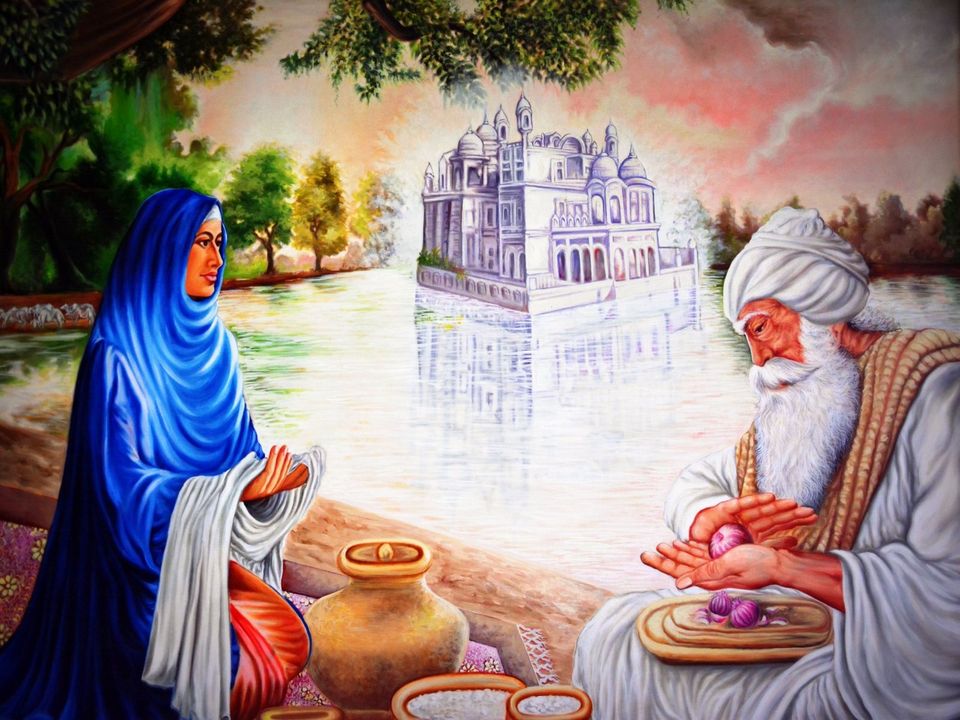
Bhai Gurdas’s and Baba Buddha’s Attempts
Guru Arjun initially sent Bhai Gurdas to request the collection of Shabads from Mohan. However, Mohan, feeling overlooked for Guruship, refused to answer the door. Baba Buddha, a revered figure in the Sikh community, also attempted to retrieve the Shabads but was unsuccessful.
Guru Arjun’s Personal Visit
In 1603, Guru Arjun found it necessary to go in person to Mohan’s house. His personal involvement highlighted the importance of the task and the significance of the Shabads for the compilation of the Guru Granth Sahib.
Singing the Hymn
Guru Arjun, rather than knocking, called out in a sweet voice and sat on Mohan’s doorstep, singing a hymn.The hymn was a poetic expression, addressing God with the name “Mohan” (the Beloved) and seeking the Blessed Vision of God’s Darshan (divine presence).
Dialogues between Guru Arjun and Mohan
Mohan, feeling aggrieved, accused Guru Arjun of stealing the Guruship from his family. Guru Arjun responded with words of love and humility, acknowledging Mohan’s beliefs in the One God.
Transformation through Song
Guru Arjun continued singing hymns, praising God and addressing Mohan. The hymns were a means of spiritually reaching Mohan’s heart and softening his stance.
Acknowledgment and Surrender
Mohan, eventually moved by Guru Arjun’s enlightened presence and the love emanating from him, acknowledged Guru Arjun’s rightful place on the throne of Guru Nanak. Mohan surrendered and handed over all the Shabads in his possession, recognizing the importance of preserving the authentic teachings of the Gurus.
Spiritual Insights in the Hymns
The hymns sung by Guru Arjun emphasized the universal presence of God, the importance of worship in thought, word, and deed, and the accessibility of divine knowledge to all.
Culmination in Unity
Guru Arjun’s visit and the subsequent acknowledgment by Mohan marked a spiritual unity, emphasizing the oneness of the Sikh community under the guidance of the Guru.
Legacy
The Shabads collected from various sources, including Mohan’s, became an integral part of the Adi Granth, later transformed into the Guru Granth Sahib. This scripture stands as the eternal Guru for Sikhs. This historical event reflects the transformative power of love, humility, and the divine word in Sikh tradition. Guru Arjun’s actions demonstrate a commitment to truth, unity, and the preservation of the authentic teachings of Sikh Gurus for the spiritual well-being of the community. This book guides Sikhs on how to live a good and spiritual life.
Work begins to compile the Aad Granth
Guru Arjun, a leader of the Sikh community, started putting together a special book called the Adi Granth. He carefully went through hymns, or Shabads, passed down from the first four Sikh Gurus. With the help of Bhai Gurdas, who wrote down the words, Guru Arjun sorted out the real hymns from the fake ones. He explained that true hymns have a special feeling that can be recognized. Guru Arjun didn’t just include hymns from the earlier Gurus—Guru Nanak, Guru Angad, Guru Amar Das, and Guru Ram Das—he also added his own. What’s unique is that he included hymns from 36 Saints from Hindu and Muslim traditions, like Kabir, Ravi Das, Naam Dev, Trilochan, and Sheikh Farid. This was the first time any religion took the writings of people from different beliefs and made them a part of its holy book. It shows Sikhs believe in one God and see everyone as part of one big family.

Guru Arjun left some empty pages in the Granth on purpose. When Bhai Gurdas asked why, Guru Arjun said that a future Guru would add more hymns at the right time. Later, Guru Gobind Singh, the tenth Guru, added hymns from Guru Teg Bahadur, completing the Siri Guru Granth Sahib. This special book, the Siri Guru Granth Sahib, is very important for Sikhs. It has teachings about how to live a good and spiritual life. The way Guru Arjun put this book together, including hymns from different traditions, shows Sikhs believe in everyone being equal and part of a big human family.
First installation of the holy Granth
In 1604, the Adi Granth was completed under the guidance of Guru Arjun and was installed in the Golden Temple, the holiest Sikh shrine. Baba Buddha, a respected figure, was appointed as the Granthi, or the caretaker of the Guru Granth Sahib. Guru Arjun conveyed to his Sikhs that the Adi Granth was not just a book but the embodiment of the Guru’s teachings. He instructed them to treat the holy scripture with the same reverence as they would treat him.
When Guru Arjun finished compiling the Adi Granth, he displayed an act of humility by placing it on his own bed and choosing to sleep on the floor. The words in the Granth were written without spaces or breaks, making it a unique format that may be challenging for many people to follow in the present day.
Later, Guru Gobind Singh, the tenth and last of the Sikh Gurus in human form, played a crucial role in preserving and expanding the Guru Granth Sahib. He dictated the entire Granth Sahib at Talwandi Sabo, which is now known as Damdama Sahib. However, a complication arose when Dhir Mal, the son of Baba Gurditta and the grandson of Guru Hargobind, refused to hand over the Adi Granth to Guru Gobind Singh. In a taunting manner, Dhir Mal challenged the Guru, saying, “If you are a Guru, then prepare your own.”
This incident marks a moment of tension within the Sikh community, with Dhir Mal questioning Guru Gobind Singh’s authority. Despite the challenges, Guru Gobind Singh went on to play a pivotal role in the evolution of the Sikh faith, establishing the Guru Granth Sahib as the eternal Guru for Sikhs and ensuring the continued spiritual guidance of the community.
Guru Gobind Singh recreates holy Granth
Guru Gobind Singh faced a problem when someone refused to give him the holy book called the Adi Granth. So, Guru Gobind Singh, who was the tenth leader of the Sikhs, decided to recreate the whole Granth. He told a person named Bhai Mani Singh all the teachings, and Bhai Mani Singh wrote them down on paper. Some people might wonder if this story is true, but it’s important to know that Guru Gobind Singh was not an ordinary person—he was considered very special and divine by Sikhs.
In those days, not many people could read or write. Instead, stories and important teachings were passed down through speaking and listening. People who knew a lot could remember entire poems or religious texts. For example, some Muslims could recite the whole Qur’an, and Hindu priests could do the same with the Mahabharata. The Sri Guru Granth Sahib, which is the holy book of the Sikhs, is designed in a way that makes it easier to remember because it’s set to music and rhythm. Guru Gobind Singh added the teachings of his father, Guru Teg Bahadur, to the new Granth, but he didn’t include his own teachings in it. He kept his own writings in a different book called the Dasam Granth. It’s important to know that even though the Dasam Granth is significant, Sikhs don’t consider it as their Guru.
The whole process of rewriting the entire Guru Granth Sahib was finished in 1705, and the new scripture was taken to a place called Nanded, where it was installed. The Guru Granth Sahib is still very important to Sikhs today. It gives them guidance on how to live a good and spiritual life.
Installation as Perpetual Sikh Guru
On October 20, 1708, something very important happened in Sikh history. Guru Gobind Singh, who was the leader of the Sikhs, made a big decision. He officially made the Guru Granth Sahib, which is a holy book, the eternal Guru. This special day is now celebrated as Guru Gadi Divas or Enthronement Day. During his last moments, Guru Gobind Singh told the Khalsa, which is the community of Sikhs who had been initiated, that if they wanted to see him, they should turn to the Guru Granth Sahib. He said, “Obey the Granth Sahib, for it is the visible body of the Guru. Let any who desire to meet me, diligently search its Bani.”
By saying this, Guru Gobind Singh made the Guru Granth Sahib very, very important. He made it clear that the teachings and wisdom in the Guru Granth Sahib were going to be the guide for Sikhs forever. Guru Gobind Singh explained that the Word of God, which had been the Guru in the teachings of Guru Nanak and the ten Gurus after him, was now back to its original form as the Word—the Bani, the Shabad. This was a big change in Sikhism. Instead of having a human Guru, Sikhs were told to always look to the Guru Granth Sahib for guidance. This decision emphasized that the teachings in the Guru Granth Sahib are universal and timeless. Sikhs all around the world now celebrate Guru Gadi Divas to remember and honor this important moment in their history.
Structure of the Guru Granth Sahib
The Guru Granth Sahib is an important book for Sikhs, and it’s quite big with 1430 pages. Inside, there are hymns called shabads, and they are organized in thirty-one Ragas, which are like musical patterns. The arrangement follows the order of the Sikh Gurus, and the hymns of Hindu and Muslim Saints come after. The shabads have different rhythms, like Ashtapadi (eight steps) or Panch-padi (five steps). The whole book is written in a script called Gurmukhi, even though the hymns were originally in Punjabi, Sanskrit, and Persian.
In the original manuscript of the Guru Granth Sahib, there was no index to help find things easily. But in some newer versions, there is an index that shows where different sections start and end. For example, the index says that the Japji Sahib starts on page 1 and ends on page 8. Sukhmani Sahib is from pages 262 to 296, the Bara Maha bani is on pages 133 to 136, and the bani called Anand Sahib (Bliss) can be found from pages 917 to 922.
This way of organizing the book makes it easier for people to find specific hymns or parts they want to read or study. The Guru Granth Sahib is not just rich in spiritual teachings; it also has a nice structure that reflects the culture and music of the Sikh tradition.
The Beginning
The Guru Granth Sahib starts with the important word “Ek Onkar,” which means the All Pervading Being. This leads to the Mool Mantra, a key part of Sikhism made up of ten words ending with “Gur-parshad.” Next is Japji, a collection of 38 stanzas, along with a Prologue and an Epilogue, created by Guru Nanak Dev. Sikhs recite Japji during their morning prayer.
Then there are two parts: (1) “So Dar” and (2) “So Purkh.” “So Dar” has 5 hymns, and “So Purkh” has 4. Together, these make up a significant part of the evening prayer called Rehras, which is crucial in Sikh daily routines. Additionally, there’s Sohila (or Kirtan Sohila), with 5 hymns, used as a bedtime prayer.
These compositions are highly important in Sikh tradition. Japji is central to morning prayers, Rehras for the evenings, and Sohila for bedtime. They play a vital role in Sikhs’ daily spiritual practices, connecting them with the divine and reflecting the teachings of the Gurus.
The 31 Ragas
The Adi Granth, the holy scripture of Sikhism, is divided into 31 Ragas or chapters, each with its unique musical structure. A Raga serves as a musical framework, providing rules on how to create a melody by defining scales, note movements, and emphasis. This organization allows for the composition and variation of melodies within the parameters of a specific Raga. The Adi Granth begins with a section that is not associated with a specific Raga, featuring Japji, Rehras, and Kirtan Sohila. Following this, the primary section unfolds with the 31 Ragas. Each Raga carries its emotional tone, and each chapter holds spiritual significance.
The sequential order of the thirty-one ragas includes Sri raga, Manjh, Gauri, Asa, Gujri, Devagandhari, Bihagara, Wadahans, Sorath, Dhanasri, Jaitsri, Todi, Bairari, Tilang, Suhi, Bilaval, Gond (Gaund), Ramkali, Nut-Narayan, Mali-Gaura, Maru, Tukhar, Kedara, Bhairav (Bhairo), Basant, Sarang, Malar, Kanra, Kalyan, Prabhati, and Jaijawanti.
In the 1430 pages of the Adi Granth, you’ll also discover Saloks (verses) from Bhagat Kabir, Sheikh Farid, Guru Tegh Bahadur, and others. This intricate organization reflects the profound connection between music, emotion, and spirituality within Sikhism.
The closing section
The last part of the Guru Granth Sahib is like the closing chapter of a book. It has two parts. The first is called Mundavani, which is like a concluding seal or message. Guru Arjan wrote this verse to wrap up the teachings in the scripture.
The very last composition in the Guru Granth Sahib is called Ragamala. It’s a set of verses traditionally describing different musical modes (ragas) and connecting them with specific times of the day. However, some discussions and disagreements exist within the Sikh community about whether Ragamala was part of the original text. Some say it wasn’t, while others argue for its historical importance. So, in simple terms, the closing section with Mundavani and Ragamala is like the final words that bring the teachings of the Guru Granth Sahib to a thoughtful end, just like the conclusion of a meaningful journey.
Gurugaddi Diwas Celebration
The Gurugaddi Diwas of Guru Hargobind Ji is celebrated annually on June 24th. Sikhs around the world commemorate this day with prayers, kirtan (devotional singing), and religious gatherings. Special programs and events are organized in gurdwaras (Sikh temples) to honor the significance of this historical event. Sikhs reflect on the teachings and contributions of Guru Hargobind Ji and express gratitude for the spiritual guidance provided by the Gurus.
In today’s world, the celebration of Gurugaddi Diwas continues to be a moment of reverence and reflection for the Sikh community. It is an occasion to reinforce the values of selfless service, compassion, and devotion to the teachings of the Gurus. Sikhs attend special congregations, listen to hymns and discourses, and participate in community service as a way of honoring the legacy of Guru Hargobind Ji and the continuation of the Guru’s divine light.
Gurugaddi Diwas serves as a reminder of the continuity of spiritual leadership within Sikhism and the enduring impact of the Gurus’ teachings on the lives of their followers. It is a day of celebration, devotion, and spiritual reflection for Sikhs worldwide.
In Amritsar Celebration
Sikhs from all over gather to participate in the festivities, marking the transfer of Guruship to Guru Hargobind Ji. The celebration typically involves various religious and community-oriented activities. Here’s a general overview of how Gurugaddi Diwas is celebrated in Harmandir Sahib:
Akhand Path
Prior to Gurugaddi Diwas, an Akhand Path (continuous reading of the Guru Granth Sahib) is initiated. The Akhand Path usually starts a few days before the actual celebration and concludes on the day of Gurugaddi Diwas.
Religious Discourses and Kirtan
Special kirtan programs (devotional singing) and religious discourses are organized inside the Harmandir Sahib complex. Renowned Ragi Jathas (musical groups) and religious scholars are often invited to perform kirtan and share spiritual insights.
Nagar Kirtan
A Nagar Kirtan, which is a religious procession, is organized in and around the city of Amritsar. Sikhs participate in the procession, singing hymns, and carrying the Guru Granth Sahib in a decorated palanquin.
Langar Seva
The tradition of langar (community kitchen) holds special significance during Gurugaddi Diwas. Langars are organized to serve free meals to all visitors, irrespective of their background. This practice reflects the Sikh principles of equality, community service, and selfless giving.
Gurbani Recitation
The reading of Gurbani (scripture from the Guru Granth Sahib) and recitation of hymns continue throughout the day. Devotees often gather to listen to the sacred verses and seek spiritual inspiration.
Fireworks Display
In the evening, a fireworks display may take place, adding a festive and celebratory atmosphere to the occasion.
